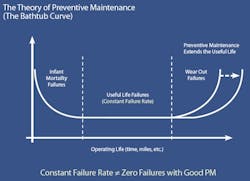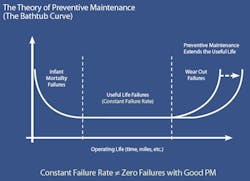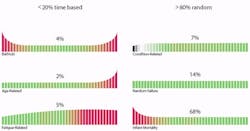Reliability-Centered Maintenance
Preventive maintenance is so institutionalized in many facilities today that facilities engineers don't even stop to question whether their maintenance practices affect system reliability. Up to 50 percent of unplanned downtime occurs in systems that were "serviced" within the previous 7 days, according to research from the Palo Alto, CA-based Electric Power Research Institute and the U.S. Navy. So, if the goal of the preventive maintenance program is truly to prevent building-system interruptions, it's time for facilities engineers to reconsider their approach to maintenance.
Reliability-centered maintenance is much more than just another way to do maintenance. In a nutshell, it's a way of looking at system performance in terms of the impact of a failure and then mitigating those results by design, detection, or effective maintenance.
You don't need to understand every detail about your systems to practice reliability-centered maintenance; rather, you must understand what components and equipment can be allowed to fail, what must be monitored, and what the consequences are of the failure.
While this approach requires a good understanding of design constraints and system-performance data, you don't need a time-consuming and expensive process to positively impact most facilities systems.
Many professionals view reliability-centered maintenance and predictive technologies as add-on technologies to a preventive maintenance program; however, reliability-centered maintenance is a tool that redesigns your overall maintenance strategy to improve system performance. An outcome of a reliability-centered maintenance analysis might show that you need to improve or replace some system components or equipment, improve your monitoring capabilities, or change or eliminate preventive maintenance activities.
Why Isn't Preventive Maintenance Enough?
Let's take a step back for a second and examine why preventive maintenance alone doesn't cut it. Certainly, all facilities engineers agree that good basic maintenance, including lubrication, filter changes, cleaning, and inspection, is critical for extending asset life.
Preventive maintenance is based on replacing systems or components after a certain length of time or amount of use to extend the operating life of equipment. A lot of facilities equipment has failure characteristics that are shaped in a pattern like a bathtub curve (see Figure 1), meaning that it begins with a high incidence of failure (known as infant mortality); is followed by a lower, constant probability of failure; and is then followed by a wear-out zone where failure probability is high again.
The problem with this line of thinking (for those who want to improve building-system reliability) is that the area under the curve in the constant failure region is not zero. Most preventive maintenance is designed to address only basic maintenance issues, not to eliminate failures. This difference alone should sound an alarm for any facilities engineer with critical systems responsibilities.
There are at least six different failure patterns that equipment might experience (see Figure 2):
- Bathtub, occurring as described above.
- Age-related, an increasing probability of failure throughout the equipment's life.
- Fatigue-related, such as component wear-out.
- Condition-related, such as wear-out due to environmental conditions.
- Random failure, meaning there's a probability of failure at any time.
- Infant mortality, meaning a high number of early failures.
These varied failure patterns demonstrate that a normal preventive maintenance program is not likely to deliver the results you want if reliability improvement is your goal.
What's in It for Me?
A simple example shows the benefits of reliability-centered maintenance to your overall maintenance strategy. A normal preventive maintenance routine for HVAC systems might include replacing filters at scheduled intervals, cleaning coils periodically, and recording amperage readings on the motors. While this is good basic "equipment" maintenance, it does not necessarily help you detect problems that will impact operating efficiency, process, or comfort cooling.
Applying reliability-centered maintenance helps you focus your attention on outcomes. In the HVAC maintenance example, you could use remote-monitoring technology to measure operating characteristics, like the air-discharge temperature at the evaporator vs. the controls setpoint, to detect a low refrigerant problem. Other activities can help identify dirty coils or filters, and other things that can impact reliability and operating efficiency - regardless of when preventive maintenance is due.
Old-School Thinking
Shifting perceptions about the goals of a maintenance program means rethinking how you do your job and how you add value to the organization. A typical "old-school" way of thinking about maintenance asserts that small, chronic problems are unimportant to management. Only when large losses occur - like major equipment breakdowns, a safety emergency, or a power outage - do facilities issues grab the attention of management.
If management only values you as a "firefighter" who can come to the rescue and extinguish large problems, you may not get a seat at the management table when important decisions are being made about long-term facilities issues.
New Realities
Certainly, all successful facilities engineers are highly valued for their ability to solve urgent problems; however, the new reality is that businesses are focusing on quality, continuous improvement, and ongoing cost reductions, according to a Houston-based Intl. Facility Management Association (IFMA) 2006 future outlook panel. These are easy goals to establish and measure.
Facilities teams must develop new skills to influence the thinking of the corporate suite and demonstrate how the physical facility impacts the bottom line - either positively or negatively - and impacts people, processes, and equipment in a facility.
Advancements in remote monitoring and controls technology are making it easier to gather the data needed to help make your case. Technology is dramatically improving productivity, the quality of results, and decision-making capabilities. As a facilities engineer, you know the value of information in improving your decisions, and data improves your ability to add value to your customer's primary mission.
Facility Needs Must Meet Business Objectives
In order for reliability-centered maintenance to benefit your organization, it is important to be sure that your facilities' operations and maintenance plans align with your organization's objectives. In the past, many facilities engineers relied on annual shutdowns to catch problems. But, with the increased pace of business and a heavy reliance on facilities systems, you may not be able to rely on luck to catch all of your problems.
It is not uncommon these days for businesses to radically change direction, putting a lot of stress on the facilities systems that are critical for success. Successful facilities engineering programs are aligned to meet changing organizational requirements for capacity, quality, reliability, and cost. Most importantly, activities must always focus on ROI.
For instance, it might be costly to design and replace an entire floorcovering, but if traffic-related wear patterns show it's going to need constant repairs, redesigning or choosing a different manufacturer or material might provide the most benefit for the least cost.
Data Opens the Door to Success
A key benefit of reliability-centered maintenance is that it helps you develop the data to justify repairs or replacements. Using hard facts, you can link the physical facility to the core business goals of your organization. Typical links include the ability of the facility to help organizations meet new and evolving safety, environmental, health, and regulatory requirements.
You can use data to show the cost impact of utilities, equipment, and systems interruptions on business operations. If the roof is leaking in the hospital's operating room, the facility could experience serious contamination and lost revenue. Likewise, an upgrade could be hard to pass up on a new HVAC system if it will pay for itself in energy savings within a year and provide increased employee productivity from better air quality.
What's Your Top Priority?
To implement a reliability-centered maintenance program, you'll need to re-evaluate your facility's overall maintenance strategy to focus on the "vital few" vs. the "trivial many." Instead of doing routine maintenance on every single system in the building, prioritize your maintenance activities. Data helps you decide what to perform and when to do it.
Some equipment is critical to building operations - without it, your organization couldn't continue business as usual (e.g. the facility's power supply). On the other hand, re-striping the parking lot may be a lesser priority. Prioritizing based on this information can help reduce maintenance costs and improve reliability of equipment.
|
Tips to Optimize Your Reliability-Centered Maintenance Plan
|
It's as Easy as 1-2-3
The following steps can help you create a reliability-centered maintenance program:
- Assess elements of your facility's infrastructure: operating costs, performance results, regulatory requirements, and capacity.
- Identify potential gaps: redundancies in your current activities, areas where you could cut costs, and places where you could improve performance.
- Collect operating data for various systems (like energy or water use) - analyze it and create a strategy that includes the potential gaps you've identified.
- Using this information, consider potential solutions and pros and cons of different maintenance approaches.
- Develop a roadmap that presents the budget for improvements, a plan for technology integration, a monitoring plan, and a schedule of maintenance milestones you hope to achieve.
If these tasks seem too time consuming, a good choice could be to hire a specialist to conduct the analysis and make recommendations.
Remember that most maintenance and operations processes have never been optimized - costs reduced, perhaps, but not optimized. Reliability-centered maintenance can help you redesign your maintenance program around results instead of time completions or other meaningless metrics.
Consider that, almost 40 percent of the time, a preventive maintenance plan identifies a problem requiring parts that are not readily available. This fact alone results in a lot of duplication of effort, including travel time, teardown, put-back, etc. Reliability-centered maintenance, predictive technologies, and remote monitoring all have the ability to radically improve your results and eliminate wasted time and money from your existing preventive maintenance program.
Paul Wheeler is facilities engineer, facilities operations and maintenance, at La Crosse, WI-based Trane (www.trane.com). He has more than 25 years of experience in planning, design, construction, operations, and maintenance within the electronics and high-tech industry.


